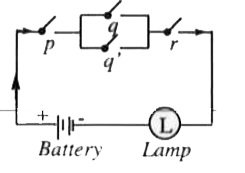When an ideal capacitor is charged by a dc battery, no current flows. However, when an ac source is used, the current flows continuously. How does one explain this, based on the concept of displacement current ?
Ideal capacitor offers infinite resistance for dc. When an ac source is used, the current flows continuously, but we know that the capacitor has dielectric between its plates. So, ideally there is no current, and circuit would be incomplete. In real capacitor is charged due to contribution of varying electric field. The current between the capacitor plates is given by displacement current.
Similar Questions
Knowledge Check
The conduction current is the same as displacement current when the source is
Aac onlyBdc onlyCeither ac or dcDneither dc nor ac
When a capacitor is charged then
lc= conduction current ld = displacembet current)
View SolutionWhen a current passes through a resistor, its temperature increases. Is it an adiabatic process?
View SolutionWhen a circuit is switched on, current flows through the circuit with the speed of light because
View SolutionWhen does the current flow through the following circuit ?

View SolutionAn an ideal parallel LC circuit, the capacitor is charged by connecting it to a DC source which is then disconnected. The current in the circuit
View SolutionA parallel plate capacitor 20 μF is being charged by a voltage source whose potential is changing at the rate of 3 V/s. The conduction current through the connecting wires, and the displacement current through the plates of the capacitor, would be, respectively:
View SolutionA capacitor has been charged by a DC source. What are the magnitude of conduction and displacement current when it is fully charged?
View Solution
